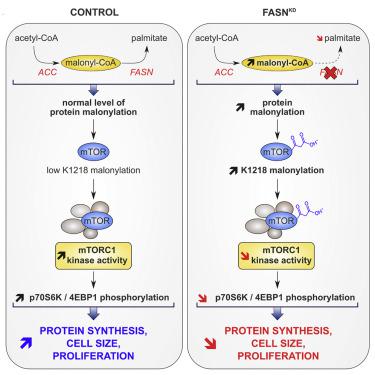当前位置:
X-MOL 学术
›
Cell Metab.
›
论文详情
Our official English website, www.x-mol.net, welcomes your
feedback! (Note: you will need to create a separate account there.)
Impairment of Angiogenesis by Fatty Acid Synthase Inhibition Involves mTOR Malonylation.
Cell Metabolism ( IF 27.7 ) Pub Date : 2018-Dec-04 , DOI: 10.1016/j.cmet.2018.07.019 Ulrike Bruning , Francisco Morales-Rodriguez , Joanna Kalucka , Jermaine Goveia , Federico Taverna , Karla C.S. Queiroz , Charlotte Dubois , Anna Rita Cantelmo , Rongyuan Chen , Stefan Loroch , Evy Timmerman , Vanessa Caixeta , Katarzyna Bloch , Lena-Christin Conradi , Lucas Treps , An Staes , Kris Gevaert , Andrew Tee , Mieke Dewerchin , Clay F. Semenkovich , Francis Impens , Birgit Schilling , Eric Verdin , Johannes V. Swinnen , Jordan L. Meier , Rhushikesh A. Kulkarni , Albert Sickmann , Bart Ghesquière , Luc Schoonjans , Xuri Li , Massimiliano Mazzone , Peter Carmeliet
Cell Metabolism ( IF 27.7 ) Pub Date : 2018-Dec-04 , DOI: 10.1016/j.cmet.2018.07.019 Ulrike Bruning , Francisco Morales-Rodriguez , Joanna Kalucka , Jermaine Goveia , Federico Taverna , Karla C.S. Queiroz , Charlotte Dubois , Anna Rita Cantelmo , Rongyuan Chen , Stefan Loroch , Evy Timmerman , Vanessa Caixeta , Katarzyna Bloch , Lena-Christin Conradi , Lucas Treps , An Staes , Kris Gevaert , Andrew Tee , Mieke Dewerchin , Clay F. Semenkovich , Francis Impens , Birgit Schilling , Eric Verdin , Johannes V. Swinnen , Jordan L. Meier , Rhushikesh A. Kulkarni , Albert Sickmann , Bart Ghesquière , Luc Schoonjans , Xuri Li , Massimiliano Mazzone , Peter Carmeliet

|
The role of fatty acid synthesis in endothelial cells (ECs) remains incompletely characterized. We report that fatty acid synthase knockdown (FASNKD) in ECs impedes vessel sprouting by reducing proliferation. Endothelial loss of FASN impaired angiogenesis in vivo, while FASN blockade reduced pathological ocular neovascularization, at >10-fold lower doses than used for anti-cancer treatment. Impaired angiogenesis was not due to energy stress, redox imbalance, or palmitate depletion. Rather, FASNKD elevated malonyl-CoA levels, causing malonylation (a post-translational modification) of mTOR at lysine 1218 (K1218). mTOR K-1218 malonylation impaired mTOR complex 1 (mTORC1) kinase activity, thereby reducing phosphorylation of downstream targets (p70S6K/4EBP1). Silencing acetyl-CoA carboxylase 1 (an enzyme producing malonyl-CoA) normalized malonyl-CoA levels and reactivated mTOR in FASNKD ECs. Mutagenesis unveiled the importance of mTOR K1218 malonylation for angiogenesis. This study unveils a novel role of FASN in metabolite signaling that contributes to explaining the anti-angiogenic effect of FASN blockade.
中文翻译:

脂肪酸合酶抑制血管生成受损涉及mTOR丙二酰化。
脂肪酸合成在内皮细胞(ECs)中的作用仍然不完全被表征。我们报告说,EC中的脂肪酸合酶敲低(FASN KD)通过减少增殖来阻止血管发芽。FASN的内皮功能丧失会损害体内血管生成,而FASN的阻断作用会减少病理性眼部新血管形成,其剂量要比抗癌治疗的剂量低10倍以上。血管生成受损不是由于能量紧张,氧化还原失衡或棕榈酸酯消耗引起的。而是FASN KD丙二酰辅酶A水平升高,导致赖氨酸1218(K1218)的mTOR发生丙二酰化(翻译后修饰)。mTOR K-1218的丙二酰化作用会削弱mTOR复合物1(mTORC1)激酶的活性,从而降低下游靶标(p70S6K / 4EBP1)的磷酸化。使FASN KD EC中的乙酰辅酶A羧化酶1(产生丙二酰辅酶A的酶)沉默,使丙二酰辅酶A水平标准化并重新激活mTOR 。诱变揭示了mTOR K1218丙二酰化对血管生成的重要性。这项研究揭示了FASN在代谢物信号传导中的新作用,有助于解释FASN阻断剂的抗血管生成作用。
更新日期:2018-11-29
中文翻译:

脂肪酸合酶抑制血管生成受损涉及mTOR丙二酰化。
脂肪酸合成在内皮细胞(ECs)中的作用仍然不完全被表征。我们报告说,EC中的脂肪酸合酶敲低(FASN KD)通过减少增殖来阻止血管发芽。FASN的内皮功能丧失会损害体内血管生成,而FASN的阻断作用会减少病理性眼部新血管形成,其剂量要比抗癌治疗的剂量低10倍以上。血管生成受损不是由于能量紧张,氧化还原失衡或棕榈酸酯消耗引起的。而是FASN KD丙二酰辅酶A水平升高,导致赖氨酸1218(K1218)的mTOR发生丙二酰化(翻译后修饰)。mTOR K-1218的丙二酰化作用会削弱mTOR复合物1(mTORC1)激酶的活性,从而降低下游靶标(p70S6K / 4EBP1)的磷酸化。使FASN KD EC中的乙酰辅酶A羧化酶1(产生丙二酰辅酶A的酶)沉默,使丙二酰辅酶A水平标准化并重新激活mTOR 。诱变揭示了mTOR K1218丙二酰化对血管生成的重要性。这项研究揭示了FASN在代谢物信号传导中的新作用,有助于解释FASN阻断剂的抗血管生成作用。


















































 京公网安备 11010802027423号
京公网安备 11010802027423号